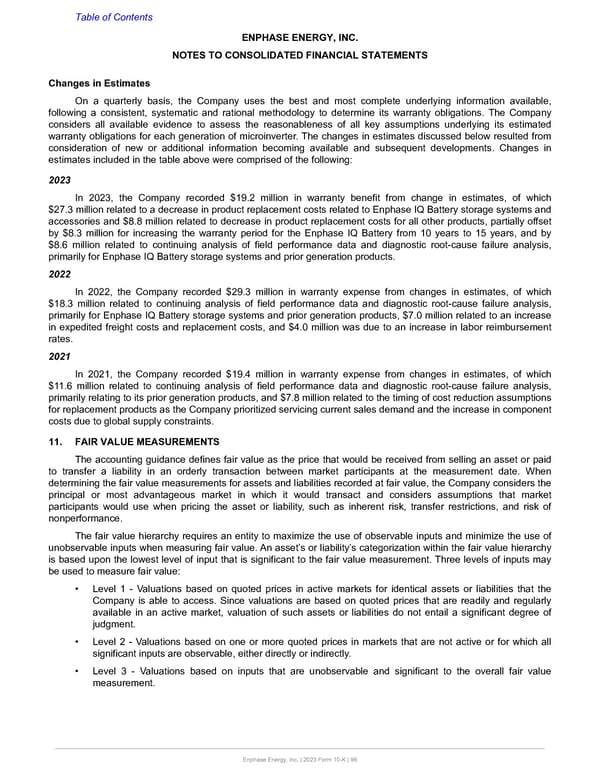Table of Contents ENPHASE ENERGY, INC. NOTES TO CONSOLIDATED FINANCIAL STATEMENTS Changes in Estimates On a quarterly basis, the Company uses the best and most complete underlying information available, following a consistent, systematic and rational methodology to determine its warranty obligations. The Company considers all available evidence to assess the reasonableness of all key assumptions underlying its estimated warranty obligations for each generation of microinverter. The changes in estimates discussed below resulted from consideration of new or additional information becoming available and subsequent developments. Changes in estimates included in the table above were comprised of the following: 2023 In 2023, the Company recorded $19.2 million in warranty benefit from change in estimates, of which $27.3 million related to a decrease in product replacement costs related to Enphase IQ Battery storage systems and accessories and $8.8 million related to decrease in product replacement costs for all other products, partially offset by $8.3 million for increasing the warranty period for the Enphase IQ Battery from 10 years to 15 years, and by $8.6 million related to continuing analysis of field performance data and diagnostic root-cause failure analysis, primarily for Enphase IQ Battery storage systems and prior generation products. 2022 In 2022, the Company recorded $29.3 million in warranty expense from changes in estimates, of which $18.3 million related to continuing analysis of field performance data and diagnostic root-cause failure analysis, primarily for Enphase IQ Battery storage systems and prior generation products, $7.0 million related to an increase in expedited freight costs and replacement costs, and $4.0 million was due to an increase in labor reimbursement rates. 2021 In 2021, the Company recorded $19.4 million in warranty expense from changes in estimates, of which $11.6 million related to continuing analysis of field performance data and diagnostic root-cause failure analysis, primarily relating to its prior generation products, and $7.8 million related to the timing of cost reduction assumptions for replacement products as the Company prioritized servicing current sales demand and the increase in component costs due to global supply constraints. 11. FAIR VALUE MEASUREMENTS The accounting guidance defines fair value as the price that would be received from selling an asset or paid to transfer a liability in an orderly transaction between market participants at the measurement date. When determining the fair value measurements for assets and liabilities recorded at fair value, the Company considers the principal or most advantageous market in which it would transact and considers assumptions that market participants would use when pricing the asset or liability, such as inherent risk, transfer restrictions, and risk of nonperformance. The fair value hierarchy requires an entity to maximize the use of observable inputs and minimize the use of unobservable inputs when measuring fair value. An asset’s or liability’s categorization within the fair value hierarchy is based upon the lowest level of input that is significant to the fair value measurement. Three levels of inputs may be used to measure fair value: • Level 1 - Valuations based on quoted prices in active markets for identical assets or liabilities that the Company is able to access. Since valuations are based on quoted prices that are readily and regularly available in an active market, valuation of such assets or liabilities do not entail a significant degree of judgment. • Level 2 - Valuations based on one or more quoted prices in markets that are not active or for which all significant inputs are observable, either directly or indirectly. • Level 3 - Valuations based on inputs that are unobservable and significant to the overall fair value measurement. Enphase Energy, Inc. | 2023 Form 10-K | 96
 Annual Report Page 95 Page 97
Annual Report Page 95 Page 97